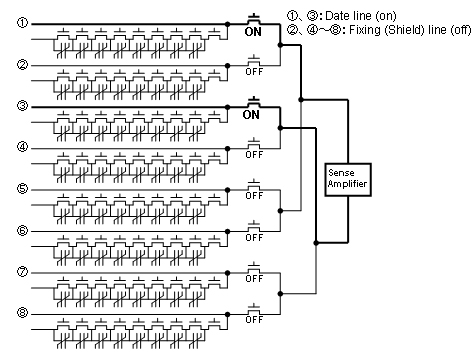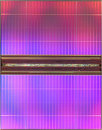Monday, February 9th 2009

Toshiba Develops World's Highest-Bandwidth, Highest Density Non-volatile RAM
Toshiba Corporation today announced the prototype of a new FeRAM -Ferroelectric Random Access Memory-that redefines industry benchmarks for density and operating speed. The new chip realizes storage of 128-megabits and read and write speeds of 1.6-gigabytes a second, the most advanced combination of performance and density yet achieved. Full details of the new FeRAM will be presented this week at the International Solid-State Circuits Conference 2009 (ISSCC2009) in San Francisco, USA.The new FeRAM modifies Toshiba's original chainFeRAM architecture, which significantly contributes to chip scaling, with a new architecture that prevents cell signal degradation, the usual tradeoff from chip scaling. The combination realizes an upscaled FeRAM with a density of 128-megabit. Furthermore, a new circuit that predicts and controls the fluctuations of power supply supports high-speed data transfers. This allowed integration of DDR2 interface to maximize data transfers at a high throughput at low power consumption, realizing read and write speeds of 1.6 gigabytes a second. In developing the new FeRAM, Toshiba broke its own record of 32-megabit density and 200-megabit data transfers, pushing performance to eight times faster than the transfer rate and density of the previous records and the fastest speed of any non-volatile RAM.
FeRAM combines the fast operating characteristics of DRAM with flash memory's ability to retain data while powered off, attributes that continue to attract the attention of the semiconductor industry. Toshiba will continue R&D in FeRAM, aiming for further capacity increases and eventual use in a wide range of applications, including the main memory of mobile phones, mobile consumer products, and cache memory applications in products such as mobile PCs and SSDs.
Outline of New Technology
1. Improvement of ChainFeRAM architecture
ChainFeRAM in the earlier generation of 64-megabit FeRAM employed a data-line design in which neighboring data-lines operated in sequence: one is off when the other is on. This allowed off lines to provide a noise barrier between on lines, contributing to chip scaling and fine performance. Previous chain architecture collected four data-lines but Toshiba has successfully increased the number of data-lines to eight, which led to a decrease in the total chip area.

2. New architecture inhibits signal degradation
Chip scaling causes signal degradation as the stored polarization of memory cell gets smaller. By shortening the data-line pitch and using chain architecture to decrease the number of memory cells connecting to sense amplifiers , Toshiba maintained the same cell signal level without any chip area penalty. Furthermore, improvement of the sensing technique reduced the parasitic capacitance and realized a reading signal of 200mV, sufficient for practical application.
3. DDR2 Interface
A circuit that can predict power fluctuation during read/write and control the power supply is newly added. This new circuit rapidly realizes the voltage required for read and write, allowing the new FeRAM to add a DDR2 interface and opening the way to practical use.
Source:
Toshiba
FeRAM combines the fast operating characteristics of DRAM with flash memory's ability to retain data while powered off, attributes that continue to attract the attention of the semiconductor industry. Toshiba will continue R&D in FeRAM, aiming for further capacity increases and eventual use in a wide range of applications, including the main memory of mobile phones, mobile consumer products, and cache memory applications in products such as mobile PCs and SSDs.
Outline of New Technology
1. Improvement of ChainFeRAM architecture
ChainFeRAM in the earlier generation of 64-megabit FeRAM employed a data-line design in which neighboring data-lines operated in sequence: one is off when the other is on. This allowed off lines to provide a noise barrier between on lines, contributing to chip scaling and fine performance. Previous chain architecture collected four data-lines but Toshiba has successfully increased the number of data-lines to eight, which led to a decrease in the total chip area.

2. New architecture inhibits signal degradation
Chip scaling causes signal degradation as the stored polarization of memory cell gets smaller. By shortening the data-line pitch and using chain architecture to decrease the number of memory cells connecting to sense amplifiers , Toshiba maintained the same cell signal level without any chip area penalty. Furthermore, improvement of the sensing technique reduced the parasitic capacitance and realized a reading signal of 200mV, sufficient for practical application.
3. DDR2 Interface
A circuit that can predict power fluctuation during read/write and control the power supply is newly added. This new circuit rapidly realizes the voltage required for read and write, allowing the new FeRAM to add a DDR2 interface and opening the way to practical use.

21 Comments on Toshiba Develops World's Highest-Bandwidth, Highest Density Non-volatile RAM
A huge leap forward if it's cost effective and when we see some software that will tolerate being put on hold like this.
This is a product i can surely do with, and its only a matter of time before the price becomes reasonable enough for the average user.
Theres software currently available that allows some applications/page file etc etc to run from a flashdisk but this is miles ahead.
Non-volatile RAM holds the data it stores without a power draw, like flash memory or static RAM (static RAM is not fast enough for the main memory, I believe it is used for the bios on the motherboard though), but it also performs (is fast access and data speed) like standard Dynamic RAM. I am not up on what speeds current Dynamic RAM operates at, but I don't think this is as fast. It is in development though, so they are working on it.
having 10TB of ram and hard drive space together would be nice.
this looks like a real step forward.
Seriously, silence freaks would jump on that.
sure its small for PC standards, but you could imagine it being very useful in mobile phones and GPS units, for example. Instant on, no boot times.